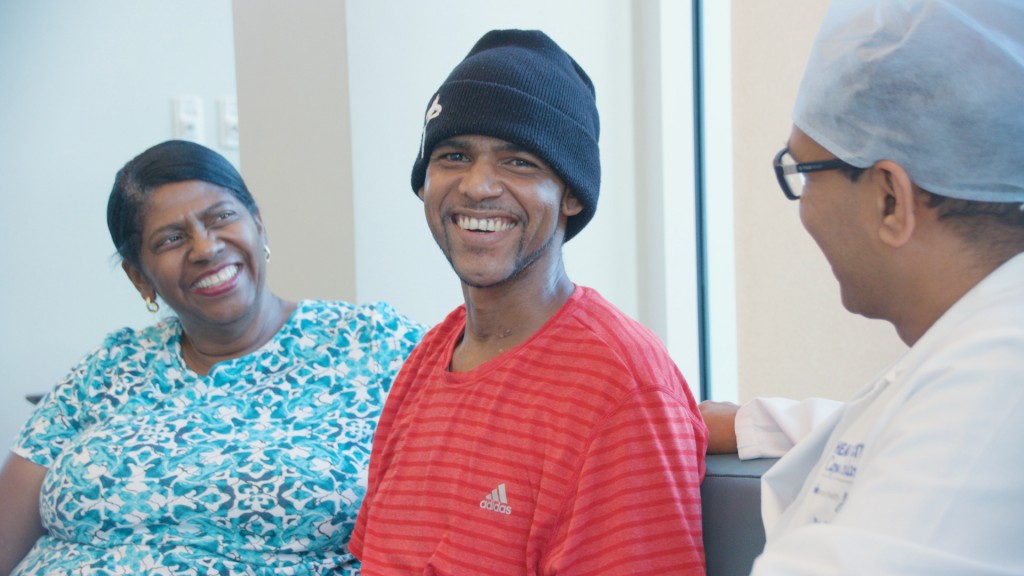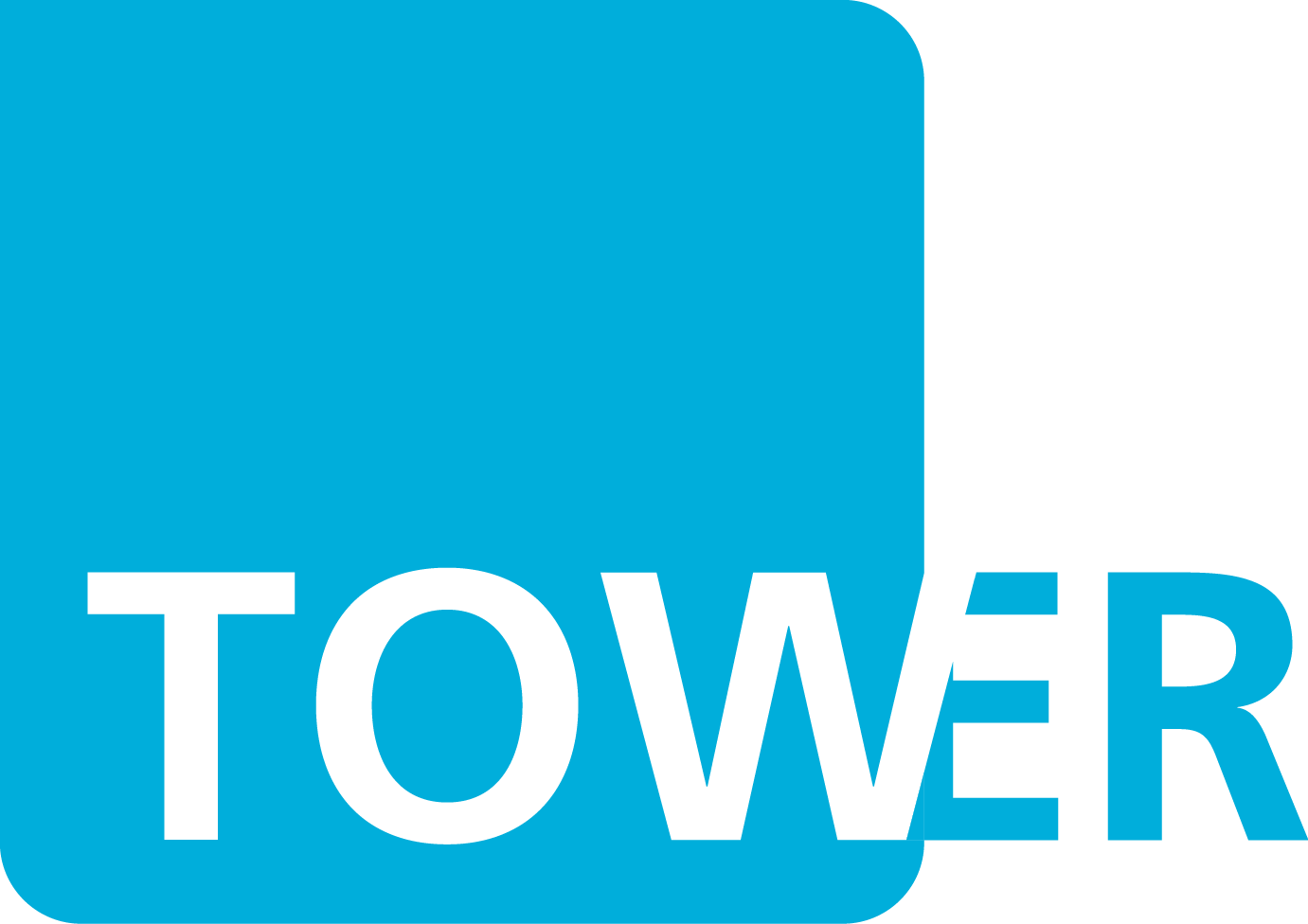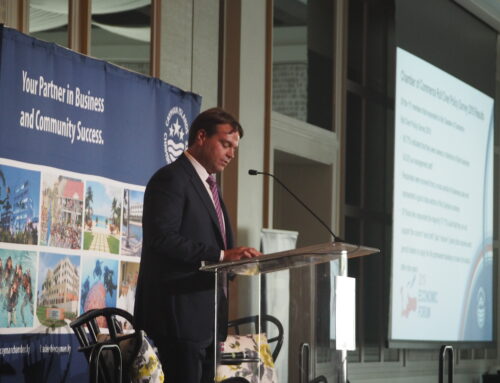A 33-year-old Caymanian father, son and brother is breathing again – with a sigh of relief – after the Health City Cayman Islands’ medical team brought him back from the brink of death.
Bjorn Ebanks’ heart stopped twice, and he underwent CPR (cardiopulmonary resuscitation) for almost 90 minutes before being placed on advanced life support and undergoing emergency surgery to remove life threatening blood clots in his lungs.

Bjorn Ebanks (center) with his mother Ingrid Ebanks speaking with Dr. Binoy Chattuparambil at Health City Cayman Islands following his recovery.
The surgical experience and skills of Dr. Binoy Chattuparambil, Health City’s Chief Cardiac Surgeon and Senior Cardiothoracic and Vascular Surgeon, saved Ebanks’ life with a procedure so difficult that fewer than 20 hospitals in the world are likely to have attempted it.
Ebanks arrived at the tertiary care facility in East End, Grand Cayman via ambulance. During the journey, he went into cardiac arrest. He was undergoing resuscitation efforts in the ambulance and while he was being brought into Health City triage.
As hospital emergency staff refused to give up on resuscitation attempts in the triage area, Dr. Binoy, as colleagues and patients call him, swiftly intervened, having just completed his morning rounds in the Intensive Care Unit.
Dr. Dhruva Kumar Krishnan is Senior Consultant in Cardiac Anesthesiology and Intensive Care at Health City. He is a certified American Heart Association’s Basic Life support /Advanced Cardiac Life Support provider as well as an Instructor. His team conducts the BLS/ACLS classes at Health City.
Dr. Dhruva recalled the extensive resuscitation efforts: “We went on for close to 90 minutes. He did come back two times and then we sort of lost [him] so we continued the cardiopulmonary resuscitation and Dr. Binoy walked in and he decided that we should try the ECMO.”
Following a rapid transfer of the patient to the operating theater, he was placed on ECMO (Extracorporeal Membrane Oxygenation) life support, which involves channeling the patient’s blood into a roller pump that serves as the patient’s “heart.”
In response to his colleagues’ concern that it might be too late for ECMO in Ebanks’ case, Dr. Binoy was confident: “I told them, if you are not doing it, it’s 100 percent death, if you are doing it then maybe one percent … for that patient it’s the only chance.”
With all hands on deck and team members performing heart massage to keep the patient alive during the procedure, Dr. Binoy recalled that it was an adrenaline-charged and intense scene: “You should have seen the whole team … everyone is up in there doing the massage on one side while we instituted the ECMO to the groin, which took me about 20 minutes.”
The emergency team waited with acute anticipation as the ECMO machine did its work.
Within five minutes Dr. Binoy’s timely intervention was vindicated as the patient’s heart slowly resumed beating: “With the ECMO he was getting better, he stabilized and I shifted him to the ICU.”
Next, Dr. Binoy sought to determine what had caused the young man’s heart to stop, and to find a solution.
He enlisted the help of the patient’s loved ones in his investigation.
“His parents and girlfriend … told us that for the last two weeks he had been very unwell, with shortness of breath,” which deteriorated to the point where he asked his girlfriend to call for an ambulance.
Dr. Binoy quickly diagnosed the problem when the patient’s mother recalled that her son was diagnosed with clots in his leg veins on two occasions – the first time in 2005 and again in 2008. After each diagnosis he was advised to take blood thinners for six months and then discontinue the medication.
With this new information in hand, Dr. Binoy immediately ordered a CT scan, which revealed that blood clots were completely blocking both lung arteries.
“There was absolutely no blood going to the lungs. So there was only one option: surgery again. From the CT scan room we took him immediately to the operating room … this surgery took almost 10 hours,” the surgeon explained.
The emergency surgery to remove the blood clots is a complicated procedure called a pulmonary endarterectomy, and involves putting the patient on a heart and lung machine.
“We had to cool the body to 20 degrees centigrade. I had to drain all the blood from the body, open both lung arteries and remove the clots from both sides,” Dr. Binoy recalled.
To allow the patient more time to recover, he was kept on ECMO for an additional 48 hours, which was needed because his brain did not initially respond well to the treatment.
“But after five to six days he was perfect, there was no neurological deficit and he started walking after six days … lung pressure returned to normal, his heart became normal. And after two weeks we sent him home,” recounted Dr. Binoy.
“I’m very happy about the outcome,” Dr. Binoy said, “it’s kind of bringing him from the grave back to life … he is such a young man. It would have been very easy to say he had cardiac arrest and that after 45 minutes nothing more could be done. But we took that one percent chance when we decided to put him on ECMO and decided to do the surgery.”
Dr. Binoy expressed his joy at this slim chance of success being realized: “It might have been a one percent chance then, but now the patient is 100 percent. For the family they’ve got their son, their boyfriend back, so it’s very, very satisfying.”
Dr. Binoy explained that the delicate and rare pulmonary endarterectomy procedure involves the use of very fine instruments for incisions and the removal of tiny clots from the lungs.
“The learning curve for this procedure is very long. That’s why there are only 10 to 20 hospitals where it has been done in the entire world. But the surgery is so gratifying,” he said.
As one of the few surgeons worldwide with extensive experience in the intricate procedure, Dr. Binoy noted: “I have been involved in at least 300 cases of this in India at the hospital where Dr. Devi Shetty, one of the experts in this surgery (and Health City’s founder), was involved. I have seen a lot. I have seen young people, who are unconscious or who are bedridden or on home oxygen, and watched them going back home to their lives.”
Relieved at having a second chance at life, Bjorn Ebanks has only praise for his surgeon and for Health City: “Dr. Binoy is a good doctor. He is one of the best I would say. Most doctors would probably have given up and said ‘alright I’m gone.’ This is a good facility, real good facility … people in here are good too and they treat you well … I’m just grateful that I am here and I can have another chance to see my family.”
The medical team was also emotional and overjoyed at Ebanks’ near miraculous recovery.
“Bjorn is extra special for us because we sort of pulled him out of nowhere…And he is a fighter, he came out of it. And I think it makes us very happy, to see people like him walk out of ICU and walk out of the hospital,” Dr. Dhruva said.
As for Ebanks, he is looking to the future with a renewed sense of purpose: “God got some plan for me. I don’t know what is, but he got some plan for me.”

